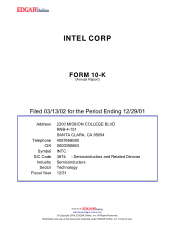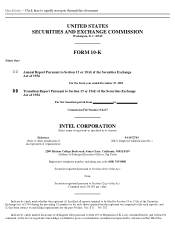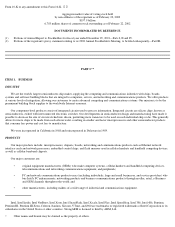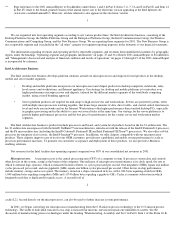Intel 2001 Annual Report Download - page 5
Download and view the complete annual report
Please find page 5 of the 2001 Intel annual report below. You can navigate through the pages in the report by either clicking on the pages listed below, or by using the keyword search tool below to find specific information within the annual report.
In 2001, we announced several new microprocessor products aimed at the various computing market segments ranging from value PCs
(systems costing less than $800) to high-performance workstations and servers.
Desktop platform. As we exited 2001, the Pentium 4 processor became our highest volume desktop processor. The Pentium 4 processor
is based on the Intel NetBurst microarchitecture, a collection of technologies that help deliver improved performance. These technologies are
especially beneficial for creating and sharing digital media, processing digital video and audio, displaying 3D graphics, and accessing a variety
of Internet technologies, including streaming video, speech processing and other multimedia processing tasks. Also, the Pentium 4 processor's
400-MHz system bus, the first in the industry, helps speed data transfer between the processor and main memory. During 2001, we introduced
four versions of the Pentium 4 processor running at speeds of 1.6 GHz to 2.0 GHz. In January 2002, we introduced the first Pentium 4
processors built on our 0.13-micron manufacturing process technology running at up to 2.2 GHz. This technology allows us to reduce the die
size by 30% and double the size of the on-chip L2 cache memory, which enhances the processor's performance.
In the value PC market segment, the Intel Celeron processor is designed to meet the core computing needs and affordability requirements
common to many new PC users. During 2001, we introduced seven new versions of the desktop Celeron processor running at speeds ranging
from 800 MHz to 1.2 GHz. The 800-MHz version, introduced in January 2001, was our first desktop value PC processor to incorporate a 100
MHz system bus. In October 2001, we introduced the Intel Celeron processor running at 1.2 GHz, the first value PC processor made on our
0.13-micron process technology. It integrates 256 KB of on-chip L2 cache, which helps improve overall performance. In January 2002, we
introduced the Intel Celeron processor running at 1.3 GHz, our fastest offering to date for the desktop value PC market segment.
Mobile platform. We design our products to provide notebook and laptop PC users with the performance they need while meeting the
power consumption and size constraints of mobile PCs. As with our desktop processors, we offer mobile processors at a variety of
price/performance points, allowing our OEM customers to meet the demands of a wide range of notebook PC designs. These notebook designs
include full size, thin and light, and ultra-portable. Within the ultra-portable design category, we provide specialized low voltage processors,
which consume as little as one watt of power on average, and ultra low voltage processors, which consume as little as half a watt of power on
average. Low voltage processors are targeted for the mini-notebook market segment while ultra low voltage processors are targeted for the sub-
notebook market segment of mobile PCs weighing less than three pounds and measuring one inch in height.
During 2001, we introduced 29 mobile processors, providing solutions across a wide range of market segments. We introduced the Mobile
Intel Pentium III Processor-M at speeds of up to 1.2 GHz; the low voltage mobile Pentium III processor running at up to 800 MHz; and the
ultra low voltage Mobile Pentium III processor running at up to 700 MHz. Our Mobile Intel Pentium III processor features Intel® SpeedStep™
technology. When the user is disconnected from an AC power source, this technology allows the processor to switch automatically to a lower
voltage and clock speed, extending the system's battery life. When the user plugs into an outlet or docking station, the chip automatically
resumes full speed. We also introduced mobile Celeron processors ranging from 733 to 933 MHz,
3
aimed at the mobile value PC market segment, as well as low voltage mobile Celeron processors at 600 and 650 MHz and ultra low voltage
mobile Celeron processors at 500 and 600 MHz.
In March 2002, we introduced the Mobile Intel Pentium 4 processor-M running at speeds up to 1.7 GHz. This new processor is designed
to enable both consumer and business users to take full advantage of processing-intensive applications such as audio and video encoding,
digital imaging, speech recognition, 3D content creation, games, multimedia and multi-tasking environments.
Server and workstation platforms. In 2001, we expanded our server product offerings in order to provide building blocks for solutions
across a wide range of server market segments. In September 2001, we began shipping in volume Intel Pentium III Xeon processors for use in
high-performance multiprocessing servers, which typically use between four and eight processors per system. These processors are also being
used in servers with up to 32 processors. The Intel Pentium III Xeon processors running at 900 MHz feature 2 MB of on-die L2 cache.
For the workstation market segment, in May 2001, we introduced the first generation of Intel Xeon processors based on the Intel NetBurst
microarchitecture, running at speeds of up to 1.7 GHz. These processors are targeted for high-performance and mid-range, dual-processor
workstations. In September 2001, we introduced a 2.0 GHz version of the Intel Xeon processor based on the Intel NetBurst microarchitecture.
In October 2001, we introduced several new server building block products—boards, chassis and other server components—designed to
help OEM system builders and product integrators build their servers around Intel processors. We designed seven server board and server
chassis products to meet the specifications of a wide range of computing applications, from high-density, rack-mount server environments to e-
mail servers, print servers and database servers.
In November 2001, we introduced a new ultra low voltage processor line for low power consumption, space-saving, "ultra-dense" servers.
Ultra-dense servers are increasingly used in enterprise data centers and by Internet service providers to offer Web serving, firewall protection
and Web caching. Our ultra low voltage Pentium III processor at 700 MHz runs at 1.1 volts, and includes 512 KB of on-chip cache memory.
In December 2001, we introduced our first server building block products aimed at the telecommunications server market segment. These


















